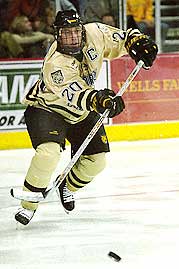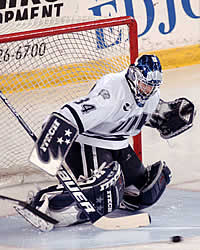With the expansion of the NCAA tournament to 16 teams this year, even knowledgeable people around college hockey have been thrown into confusion about the new seeding process. And since the NCAA has publicized its new guidelines for seeding, here is a first peek — “bracketology”-style — at what the NCAA tournament would look like if the season ended today.
It’s designed to promote discussion and debate. Given the games left in the season and the gray areas still present in the seeding process, by no means is this what the tournament will actually look like.
But it is the best logic available, given the selection criteria currently in place.
We start by assuming that the tournament winners of the CCHA, ECAC, Hockey East and WCHA are already in the Top 14 of the PairWise Rankings. This means that no team from those conferences makes the tournament that wouldn’t already have been an at-large seed.
The facts:

Here are the NCAA’s guidelines on the matter, per a meeting of the Championship Committee:
In setting up the tournament, the committee begins with a list of priorities to ensure a successful tournament on all fronts including competitive equity, financial success and likelihood of playoff-type atmosphere at each regional site. For the model, the following is a basic set of priorities:
Additionally, the NCAA recently clarified its selection criteria to include a bonus factor for “good” nonconference wins. Since the precise workings of the bonus are not yet known, that standard is not applied in this analysis.
Given these facts, let’s take a look at the current PairWise Rankings (as of March 3, 2003):
1 Colorado College
2 Maine
3 Cornell
4 Minnesota
5 New Hampshire
6 Ferris State
7 Boston College
7 Boston University
9 Michigan
10 MSU-Mankato
11 St. Cloud State
11 North Dakota
13 Providence
14 Denver
14 Ohio State
16 Harvard
16 Michigan State
16 Dartmouth
19 Minnesota-Duluth
19 Northern Michigan
21 Western Michigan
22 Massachusetts
23 Notre Dame
24 Miami
25 Merrimack
25 Yale
25 Alaska-Fairbanks
28 Mass.-Lowell
28 Wisconsin
30 Alabama-Huntsville
Step One
From the committee’s report, choose the 16 teams in the tournament.
Remember our assumption that the tournament winners of the CCHA, ECAC, Hockey East and WCHA are in the Top 14. We break ties in the PairWise Rankings by looking at the individual comparisons among the tied teams, and add the current CHA and MAAC leaders as those conferences’ autobid representatives.
The 16 teams in the tournament, in rank order, are then:
1 Colorado College
2 Maine
3 Cornell
4 Minnesota
5 New Hampshire
6 Ferris State
7 Boston College
8 Boston University
9 Michigan
10 Minnesota State
11 St. Cloud State
12 North Dakota
13 Providence
14 Denver
15 Alabama-Huntsville
16 Mercyhurst
Step Two
Now it’s time to assign the seeds.
No. 1 Seeds — Colorado College, Maine, Cornell, Minnesota
No. 2 Seeds — New Hampshire, Ferris State, Boston College, Boston University
No. 3 Seeds — Michigan, Minnesota State, St. Cloud, North Dakota
No. 4 Seeds — Providence, Denver, Alabama-Huntsville, Mercyhurst
Step Three
Place the No. 1 seeds in regionals. Following the guidelines, there is only one rule which must be enforced immediately, that of the host team being placed in its own regional. In this case, the only such team is Minnesota, so the Gophers are placed in the West Regional.
Now we place the other No. 1 seeds based on proximity to the regional sites.
Colorado College is placed in the Midwest Regional.
Maine is placed in the Northeast Regional.
Cornell is placed in the East Regional.
Step Four
Now we place the other 12 teams so as to avoid intra-conference matchups if possible.
Begin by filling in each bracket by banding groups. Remember that the teams are assigned to the regional closest to their sites by ranking order within the banding (unless you are a host school, in which case you get assigned to your home regional).
No. 2 Seeds

Boston University goes to the Northeast Regional as the host.
New Hampshire goes to the East Regional.
Ferris State goes to the Midwest Regional.
Boston College goes to the West Regional.
No. 3 Seeds
Michigan goes to the Midwest Regional as the host.
Minnesota State goes to the West Regional.
St. Cloud/North Dakota goes to the Northeast Regional (no compelling reason yet for either choice).
St. Cloud/North Dakota goes to the East Regional.
No. 4 Seeds
Providence goes to the East Regional as the host.
Denver goes to the West Regional.
Alabama-Huntsville goes to the Midwest Regional.
Mercyhurst goes to the Northeast Regional.
Now, let’s take a look at the brackets as we have set them up.
West Regional:
Minnesota vs. Denver
Boston College vs. Minnesota State
Midwest Regional:
Colorado College vs. Alabama-Huntsville
Ferris State vs. Michigan
East Regional:
Cornell vs. Providence
New Hampshire vs. St. Cloud/North Dakota
Northeast Regional:
Maine vs. Mercyhurst
Boston University vs. St. Cloud/North Dakota
Our first concern is avoiding intra-conference matchups. We see that in both the West Regional and the Midwest Regional we have this case.
We need to try to eliminate Denver vs. Minnesota and Ferris State vs. Michigan.
Addressing the Minnesota-Denver game first, Minnesota, as the host school, cannot be switched. So Denver has to move regions. Denver can switch with any of the other three No. 4 seeds, but, we can’t move Denver to the Midwest Regional since that creates another all-WCHA matchup with Colorado College. And we can’t move Denver to the East Regional since Providence is the host. That leaves Mercyhurst. So we make the switch. Denver goes to the Northeast Regional and Mercyhurst goes to the West Regional.
Now we address Ferris State vs. Michigan. Once again, Michigan, as a host school, cannot be moved. Therefore Ferris State must change places with another No. 2 seed. Likewise, Boston University cannot be moved since it is a host. That leaves New Hampshire or Boston College. New Hampshire is the higher seed of the two teams based on our original ranking of 16, so the Wildcats get to play closer to home. That means we make the switch of Boston College with Ferris State.
Where to place St. Cloud and North Dakota? North Dakota is seed “3d” while St. Cloud is seed “3c.” How about New Hampshire and Boston University? New Hampshire is “2a”; BU is “2d.” Let’s match the highest with the lowest for one game, and then we’ll have our other matchup set as well. In this case New Hampshire plays North Dakota and BU plays St. Cloud.
The brackets:
West Regional:
Minnesota vs. Mercyhurst
Ferris State vs. Minnesota State
Midwest Regional:
Colorado College vs. Alabama-Huntsville
Boston College vs. Michigan
East Regional:
Cornell vs. Providence
New Hampshire vs. North Dakota
Northeast Regional:
Maine vs. Denver
Boston University vs. St. Cloud
We now add two ad hoc steps to finish out the selections.
Step Five
Examine the brackets for final, equitable changes.
We can switch Alabama-Huntsville and Mercyhurst. The logic for doing this is that Colorado College, as the top seed, should play the 16th overall selection, Mercyhurst. So we’ll make that switch.
So we have our tournament bracket.
West Regional:
1 Minnesota vs. 4 Alabama-Huntsville
2 Ferris State vs. 3 Minnesota State
Midwest Regional:
1 Colorado College vs. 4 Mercyhurst
2 Boston College vs. 3 Michigan
East Regional:
1 Cornell vs. 4 Providence
2 New Hampshire vs. 3 North Dakota
Northeast Regional:
1 Maine vs. 4 Denver
2 Boston University vs. 3 St. Cloud
Now we can bracket the Frozen Four. If all four number one seeds advance, then the No. 1 seed plays the No. 4 seed and the No. 2 seed plays the No. 3 seed. Therefore, the winners of the West and Midwest Regionals face each other in one semifinal (Minnesota and Colorado College’s brackets), while the winners of the East and Northeast Regionals (Cornell and Maine’s brackets) face each other in the other semifinal.
Step Six
Sit back, discuss and enjoy the hockey.
We’ll be back next Monday with an updated look at the potential NCAA tournament brackets.


